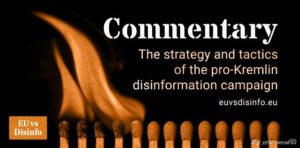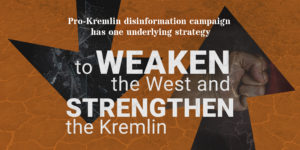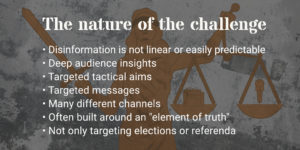Factory of Lies is the name of a new television documentary introducing a number of journalists who have uncovered the hidden processes of the disinformation campaigns coming from Russia, EU vs Disinfo reports. Some of these journalists are themselves Russians who have not been afraid of doing this kind of investigative work in the difficult conditions of their country’s highly controlled media environment.
 The Kremlin’s disinformation campaign should be taken with the highest level of seriousness. It is part of Russian military doctrine and accepted by the top hierarchy of the most important state-owned media, according to a new analysis.
The Kremlin’s disinformation campaign should be taken with the highest level of seriousness. It is part of Russian military doctrine and accepted by the top hierarchy of the most important state-owned media, according to a new analysis.
The pro-Kremlin disinformation campaign has one underlying strategy. Despite the diversity of messages, channels, tools, levels, ambitions and tactical aims, and notwithstanding its rapidly adapting nature, the strategic objective is one and the same – to weaken the West and strengthen the Kremlin in a classic zero-sum game approach. However….
- Disinformation has different messages for different audiences. There are different messages for Russians and for non-Russians; and for non-Russians in different parts of the world. …
 The disinformation campaign uses different channels for different audiences. In Central and Eastern Europe, disinformation is mostly spread through dozens of dedicated outlets in local languages. …
The disinformation campaign uses different channels for different audiences. In Central and Eastern Europe, disinformation is mostly spread through dozens of dedicated outlets in local languages. …- The disinformation campaign has an unknown number of channels and speakers, some of which are operating in a non-public environment, like closed events, direct messaging platforms and through people-to-people contacts. …
- The campaign has different tactical aims and objectives for different audiences. It can present conspiracy theories to the audience that is ready to consume such conspiracies.. …
- The disinformation campaign has different perspectives. It can try to exploit existing divisions, or create new, artificial ones: on the more strategic level, like between the EU and NATO or the EU and the US; or at a national level, like between Western Europe and Eastern Europe, or two countries with historical issues….
 The disinformation campaign has different levels of ambition. The objective in 2014 was to help Russia achieve its military goals in Crimea. European elections and referenda were targeted in 2016 and 2017 in order to weaken consensus within Europe on the policy towards Russia. But it is not only about targeting elections or referenda. …. …. RTWT
The disinformation campaign has different levels of ambition. The objective in 2014 was to help Russia achieve its military goals in Crimea. European elections and referenda were targeted in 2016 and 2017 in order to weaken consensus within Europe on the policy towards Russia. But it is not only about targeting elections or referenda. …. …. RTWT
The future arrived first in Russia simply because the old world died there harder and faster, and then spread to the West, with all the now too-familiar negative consequences. But for all its tragedy, there was also a sense of possibility then—as now, notes analyst Peter Pomerantsev.
Belief in big, rational (or supposedly rational) ideas of progress and the future crashed there first. First communism, then by the mid 1990s democratic capitalism. Old identities folded too, more dramatically than elsewhere, he writes for the American Interest:
 “We were an absolutely blank canvas. The Soviet concepts of ‘workers,’ ‘collective farmers,’ ‘intelligentsia’ had nothing at all to do with politics,” remembers Gleb Pavlovsky (left), one of the 1990s spin doctors, who started to work out a new approach to politics where 20th century identities and ideologies were gone. ….
“We were an absolutely blank canvas. The Soviet concepts of ‘workers,’ ‘collective farmers,’ ‘intelligentsia’ had nothing at all to do with politics,” remembers Gleb Pavlovsky (left), one of the 1990s spin doctors, who started to work out a new approach to politics where 20th century identities and ideologies were gone. ….
If Russia is where the future first arrived, then it’s a warning too. The only way to keep a magicked up “majority” together is through finding bigger and badder conspiracies to play at  war with. [Bulgarian political scientist Ivan] Krastev (right), has playfully asserted that a certain type of Western liberal’s newfound alarm at Russian “interference” is powered by a deeper fear, that what’s left of the West is becoming more like Russia: the lack of belief in any positive ideology, the wild relativity, elections which change nothing, and institutionalized corruption.
war with. [Bulgarian political scientist Ivan] Krastev (right), has playfully asserted that a certain type of Western liberal’s newfound alarm at Russian “interference” is powered by a deeper fear, that what’s left of the West is becoming more like Russia: the lack of belief in any positive ideology, the wild relativity, elections which change nothing, and institutionalized corruption.







